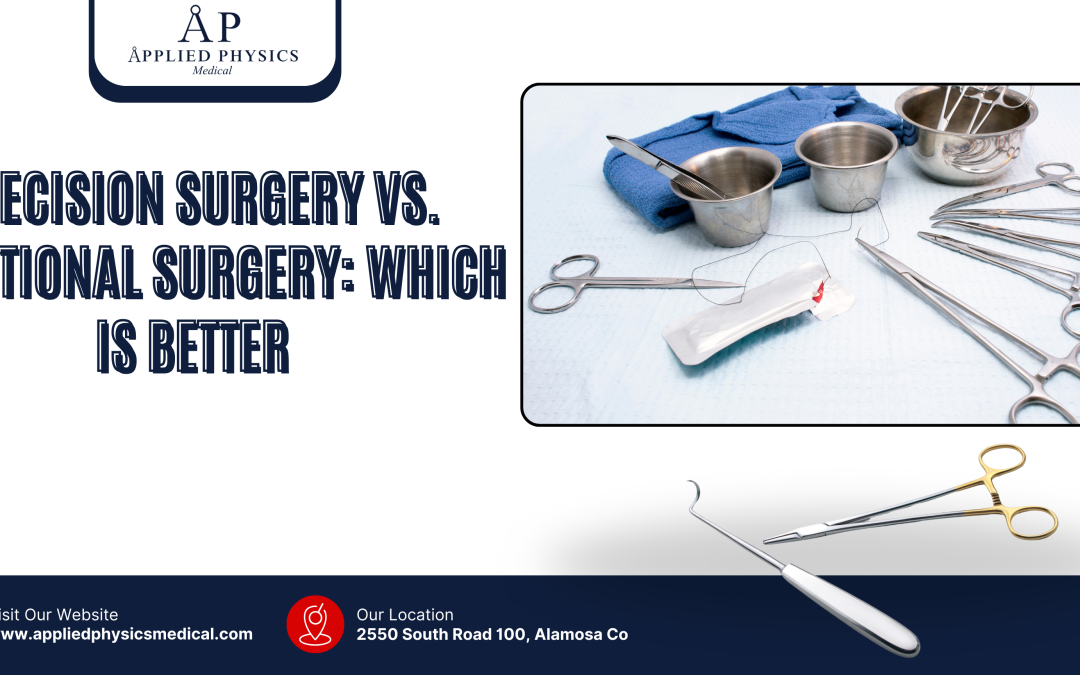Introduction
Precision surgery, also known as minimally invasive surgery, is a modern surgical technique that utilizes advanced technology and specialized instruments to perform procedures with greater accuracy and precision. This approach allows surgeons to operate with smaller incisions, resulting in less trauma to the body and faster recovery times for patients. On the other hand, traditional surgery involves larger incisions and more invasive techniques, often requiring longer hospital stays and recovery periods.
Precision surgery has revolutionized the field of surgery by offering patients a less invasive option for a wide range of procedures, including but not limited to, orthopedic, gynecological, and urological surgeries. With the use of laparoscopic and robotic-assisted techniques, precision surgery has become increasingly popular due to its ability to minimize scarring, reduce pain, and lower the risk of complications. Traditional surgery, on the other hand, remains a common approach for many surgical procedures, particularly those that require open access to the body’s organs or tissues.
Key Takeaways
- Precision surgery offers more accurate and targeted procedures compared to traditional surgery
- Precision surgery allows for smaller incisions, less damage to surrounding tissues, and faster recovery times
- Traditional surgery may be more accessible and cost-effective for some patients
- Precision surgery may have higher upfront costs but can lead to better long-term outcomes and reduced recovery time
- The future of surgical techniques is moving towards precision surgery, with the potential for significant impact on the medical field
Advantages and Disadvantages of Precision Surgery
One of the main advantages of precision surgery is its ability to minimize trauma to the body. By using smaller incisions and specialized instruments, precision surgery reduces the risk of excessive bleeding, infection, and post-operative pain. Additionally, patients who undergo precision surgery often experience shorter hospital stays and faster recovery times, allowing them to return to their normal activities sooner.
However, precision surgery also has its drawbacks, including the need for specialized training and equipment, which can limit its accessibility in some healthcare settings. Furthermore, the cost of precision surgery may be higher than traditional surgery due to the use of advanced technology and specialized instruments. Another advantage of precision surgery is its ability to provide surgeons with enhanced visualization and control during procedures.
With the use of laparoscopic and robotic-assisted techniques, surgeons can navigate through the body’s internal structures with greater precision, reducing the risk of damage to surrounding tissues. However, precision surgery may also have limitations in certain complex or emergency cases where open access to the body is necessary. Additionally, some patients may not be suitable candidates for precision surgery due to underlying health conditions or anatomical factors.
Advantages and Disadvantages of Traditional Surgery
Traditional surgery has been a cornerstone of medical practice for centuries and continues to be a widely used approach for many surgical procedures. One of the main advantages of traditional surgery is its versatility and ability to address a wide range of complex cases that may not be suitable for precision techniques. Traditional surgery also offers surgeons direct access to the body’s organs and tissues, allowing for thorough examination and intervention when necessary.
However, traditional surgery often requires larger incisions and more invasive techniques, which can result in longer recovery times and increased risk of complications for patients. Another advantage of traditional surgery is its widespread accessibility in healthcare settings around the world. Unlike precision surgery, traditional surgical techniques do not require specialized training or equipment, making them more readily available to patients in various healthcare settings.
However, traditional surgery also has its disadvantages, including higher rates of post-operative pain, scarring, and longer hospital stays compared to precision techniques. Additionally, traditional surgery may carry a higher risk of infection and other complications due to the larger incisions and more invasive nature of the procedures.
Comparison of Precision Surgery and Traditional Surgery
| Metrics | Precision Surgery | Traditional Surgery |
|---|---|---|
| Incision Size | Smaller | Larger |
| Recovery Time | Shorter | Longer |
| Blood Loss | Less | More |
| Accuracy | Higher | Lower |
When comparing precision surgery and traditional surgery, it is important to consider the specific needs of each patient and the complexity of the surgical procedure. Precision surgery offers several advantages over traditional surgery, including smaller incisions, reduced trauma to the body, and faster recovery times. However, precision surgery may not be suitable for all patients or surgical cases, particularly those that require open access to the body’s organs or tissues.
Traditional surgery, on the other hand, remains a valuable approach for many surgical procedures due to its versatility and widespread accessibility in healthcare settings. In terms of patient outcomes, precision surgery has been shown to result in lower rates of post-operative pain, scarring, and complications compared to traditional surgery. Additionally, patients who undergo precision surgery often experience shorter hospital stays and faster recovery times, allowing them to return to their normal activities sooner.
However, traditional surgery may be necessary for certain complex or emergency cases where open access to the body is required. Despite its advantages, traditional surgery may result in longer recovery times and increased risk of complications for patients.
Patient Outcomes and Recovery Timing

The choice between precision surgery and traditional surgery can significantly impact patient outcomes and recovery time. Precision surgery offers several advantages in terms of patient outcomes, including lower rates of post-operative pain, scarring, and complications. Patients who undergo precision surgery often experience shorter hospital stays and faster recovery times, allowing them to return to their normal activities sooner.
On the other hand, traditional surgery may result in longer recovery times and an increased risk of complications due to larger incisions and more invasive techniques. In addition to faster recovery times, precision surgery also offers patients the benefit of reduced trauma to the body. By using smaller incisions and specialized instruments, precision surgery minimizes the risk of excessive bleeding, infection, and post-operative pain.
This can significantly impact patient comfort and overall satisfaction with their surgical experience. However, it is important to note that not all patients or surgical cases may be suitable for precision techniques, particularly those that require open access to the body’s organs or tissues.
The cost and accessibility of precision surgery versus traditional surgery are important factors to consider when making decisions about surgical care. Precision surgery often requires specialized training and equipment, which can result in higher costs compared to traditional surgical techniques. Additionally, not all healthcare settings may have the resources or expertise to offer precision surgery to their patients.
This can limit the accessibility of precision techniques for certain patient populations. On the other hand, traditional surgery offers widespread accessibility in healthcare settings around the world. Unlike precision surgery, traditional surgical techniques do not require specialized training or equipment, making them more readily available to patients in various healthcare settings.
Future Trends in Surgical Techniques: Precision Surgery’s Impact on the Medical Field
As technology continues to advance, precision surgery is expected to play an increasingly important role in the future of surgical care. The use of laparoscopic and robotic-assisted techniques has revolutionized the field of surgery by offering patients a less invasive option for a wide range of procedures. With continued advancements in technology and surgical techniques, precision surgery is likely to become more widely accessible in healthcare settings around the world.
In addition to its impact on patient care, precision surgery also has the potential to reduce healthcare costs by minimizing hospital stays and post-operative care. By offering faster recovery times and lower rates of complications, precision surgery can lead to significant cost savings for healthcare systems. However, healthcare providers need to continue investing in training and resources for precision techniques to ensure that all patients have access to this advanced form of surgical care.
Conclusion
Both precision surgery and traditional surgery offer unique advantages and disadvantages that should be carefully considered when making decisions about surgical care. While precision surgery provides several benefits in terms of patient outcomes and recovery time, it may not be suitable for all patients or surgical cases. Traditional surgery remains a valuable approach for many surgical procedures due to its versatility and widespread accessibility in healthcare settings.
As technology continues to advance, precision surgery is expected to play an increasingly important role in the future of surgical care by offering patients a less invasive option for a wide range of procedures. It is important for healthcare providers to continue investing in training and resources for precision techniques in order to ensure that all patients have access to this advanced form of surgical care.

